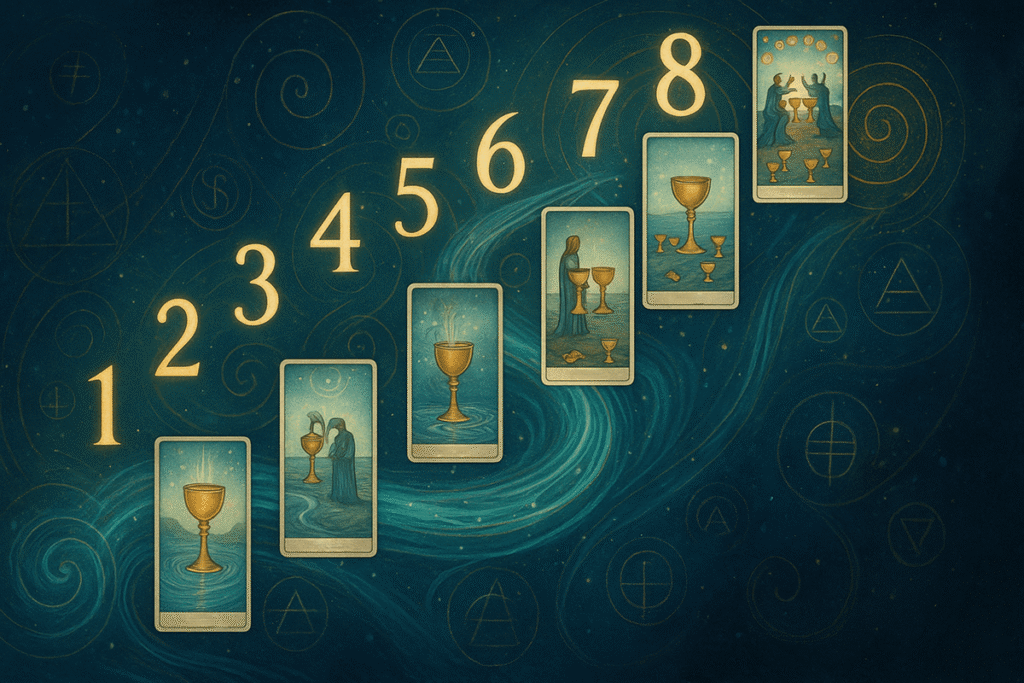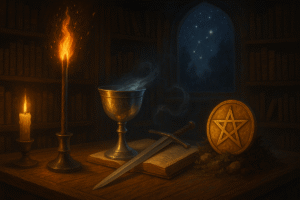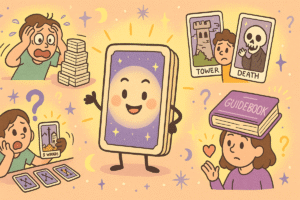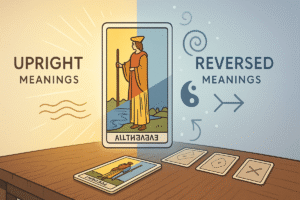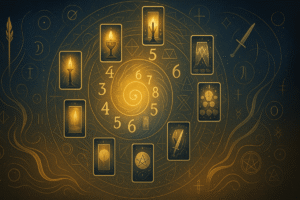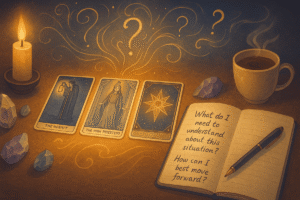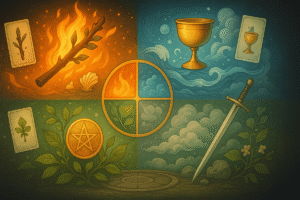Table of Contents
When I first started working with tarot cards, I’ll admit I found the Minor Arcana a bit overwhelming. There are so many cards, and they all seemed to blur together in my mind. But then something clicked when I stopped trying to memorize each card individually and started paying attention to the numbers instead. The Minor Arcana, I realized, isn’t just a collection of random images. It’s actually telling us a story, over and over again, through four different lenses.
Each number from Ace through Ten represents a stage in a journey. Think of it like chapters in a book, where the Ace is always the first page and the Ten is the conclusion. Once you understand what each number represents at its core, the entire Minor Arcana starts to make sense in a way that no amount of memorization could achieve. You begin to see patterns, anticipate themes, and most importantly, you develop your own relationship with the cards.
The Architecture of Number Energy
Numbers carry meaning in tarot that goes beyond simple counting. Each number has its own energetic signature, its own personality if you will. Perhaps that sounds abstract, but stay with me here. When you see an Ace, regardless of which suit it belongs to, you’re looking at raw potential. The number one is about beginnings, pure energy waiting to take form.
As we move through the numbers, we’re watching that initial spark develop, face challenges, find balance, and eventually reach completion. The journey isn’t always linear in real life, of course. Sometimes we circle back, sometimes we skip ahead. But understanding this numerical progression gives us a framework for reflection when we encounter these cards in our readings.
I think what makes this approach so valuable is that it respects your intelligence as a reader. You’re not being told what each card definitively means. Instead, you’re learning a language, a symbolic vocabulary that you can then apply to your own life circumstances and questions.
Aces Through Threes: The Beginning Chapters
The Ace: Pure Potential
Every Ace represents a gift, an opportunity, or a seed being planted. It’s that moment of inspiration when an idea first strikes you, or when you feel the first flutter of a new emotion. The energy here is fresh and undeveloped. What will you do with this beginning? That question is yours to explore.
The Two: Initial Response and Choice
After receiving the gift of the Ace, the Two asks what happens next. Twos often involve duality, partnership, or decision. There’s a sense of having to respond to what the Ace offered. Perhaps you’re weighing options, considering how to proceed, or finding someone to share this new energy with. The Two energy can feel both exciting and slightly uncertain.
The Three: Early Growth and Expression
By the time we reach the Three, that initial seed has sprouted. Threes represent expansion, growth, and the first tangible results of what began with the Ace. There’s often a creative or collaborative quality to Threes. The energy is generally positive, though sometimes it can indicate a need to look beyond just yourself and your immediate situation.
Fours and Fives: Stability Meets Disruption
The Four: Structure and Foundation
Fours bring a completely different energy. Here we find stability, structure, and sometimes stagnation. After the expansion of the Three, the Four asks us to pause and consolidate. What foundations are you building? What structures support you? Sometimes Fours can feel a bit too stable, actually. Like you’ve created something solid but perhaps a little rigid.
The Five: The Necessary Conflict
Then comes the Five, and honestly, Fives can be challenging cards to work with. They represent conflict, disruption, and loss. But here’s something I’ve come to appreciate over time: Fives aren’t inherently negative. They’re catalysts. The comfortable structure of the Four needed to be shaken up. Growth often requires some discomfort, some challenge that pushes us beyond where we’ve been settling.
When you see a Five in your reflections, you might ask yourself: What challenge am I facing right now? Where is life pushing me to grow beyond my comfort zone? The Five doesn’t tell you the conflict is good or bad. It simply acknowledges that it exists and invites you to consider what it might be teaching you.
Sixes Through Eights: Finding Flow
The Six: Harmony and Generosity
After the storm of the Five, the Six brings a sense of relief and balance. Sixes often carry themes of harmony, generosity, and reciprocity. There’s a quality of things flowing more smoothly here. You might be giving or receiving help, finding common ground with others, or simply experiencing a period of greater ease.
The Seven: Reflection and Assessment
Sevens introduce a contemplative energy. By this point in the journey, you’ve experienced quite a bit, and the Seven asks you to pause and reflect. What have you learned? What options do you have now? Sometimes Sevens can indicate a need to make choices based on all you’ve experienced so far. There’s often a slightly internal, thoughtful quality to these cards.
The Eight: Movement and Momentum
The energy shifts again with the Eight. After the introspection of the Seven, Eights typically indicate movement, progress, and momentum. Things are flowing forward now, perhaps rapidly. You might be leaving something behind, or you might be channeling your energy in a focused direction. Eights can feel dynamic and purposeful.
Nines and Tens: Approaching the Ending
The Nine: Near Completion
Nines sit in an interesting place. The journey is almost complete, but not quite. This can manifest as a sense of near fulfillment, or sometimes as anxiety about what comes next. Nines often represent a peak experience of whatever the suit represents, for better or worse. You’re at the top of the mountain, perhaps, but haven’t quite figured out what the view means yet.
The Ten: Full Completion
And finally, we arrive at the Ten. This is where the journey that began with the Ace reaches its natural conclusion. Tens represent completion, fullness, and the end of a cycle. What this completion looks like depends entirely on which suit you’re working with, but there’s always a sense of something being finished, of having run its full course.
Walking Through the Cups: An Emotional Journey
Let me show you how this works in practice by walking through the Suit of Cups, which deals with emotions, relationships, and matters of the heart.
The Ace of Cups offers you an overflowing chalice. New love, new emotional depth, or a fresh wellspring of compassion might be emerging. What does this emotional gift mean for you right now?
The Two of Cups explores connection and partnership. Perhaps you’re forming a bond with someone, or finding emotional resonance with another person. How do you want to respond to this connection?
By the Three of Cups, celebration and friendship bloom. There’s joy in community, in sharing your emotional abundance with others. Where in your life do you experience this kind of shared happiness?
The Four of Cups shows someone sitting under a tree, arms crossed, seemingly unimpressed by the cups before them. After all that emotional activity, perhaps boredom or apathy has set in. What are you taking for granted? What emotional offerings might you be overlooking?
The Five of Cups depicts loss and grief. Some cups have spilled. This is the emotional challenge, the heartbreak or disappointment that shakes up that stable but stagnant Four. What are you grieving? And just as importantly, what remains standing?
The Six of Cups brings nostalgia, innocence, and often reconciliation. After the pain of the Five, there’s sweetness in remembering better times or reconnecting with simpler joys. What memories or relationships might be offering you comfort now?
In the Seven of Cups, you’re faced with multiple emotional choices or fantasies. Which feelings are real? Which dreams are worth pursuing? This card asks you to examine your emotional landscape with honesty.
The Eight of Cups shows a figure walking away from stacked cups, heading toward the mountains. Sometimes emotional growth means leaving behind what no longer serves you, even if it once did. What might you need to release to move forward?
The Nine of Cups is often called the wish fulfillment card. Emotional satisfaction and contentment are here. You’ve achieved something significant in your emotional world. What does true emotional fulfillment mean to you?
Finally, the Ten of Cups depicts a family under a rainbow, a scene of lasting emotional harmony and joy. The emotional journey has reached its fullest expression. This is what emotional completion looks like: lasting bonds, deep satisfaction, and a sense of having built something enduring.
Applying This Understanding to Your Practice
Once you start seeing these numerical patterns, your relationship with tarot shifts. You’re not scrambling to remember what the Seven of Pentacles means in isolation. Instead, you’re thinking: this is a Seven, so there’s reflection and assessment happening, and it’s in Pentacles, which deals with material concerns and work. How might you be evaluating your progress in tangible, real world matters?
The beauty of understanding minor arcana numbers meaning this way is that it respects your own wisdom. The cards become prompts for self inquiry rather than external authorities telling you what to think. You develop fluency in the language of tarot rather than memorizing a fixed dictionary.
I still discover new layers to these numerical progressions, even after years of working with the cards. Sometimes the Fives feel more like liberation than loss. Other times, the Tens carry a bittersweet quality because endings always do. The framework stays consistent, but how you experience and interpret it grows with you.
What matters most is developing your own understanding through practice and reflection. Pull a card, notice its number, and ask yourself: Where am I in this particular journey right now? What stage of development is this number inviting me to explore?
Frequently Asked Questions
Do I need to memorize all 40 numbered Minor Arcana cards separately?
Not at all. Once you understand the core meaning of each number and how the four suits work, you can blend them together naturally. A Five always brings challenge or disruption, whether it appears in Cups, Wands, Swords, or Pentacles. Learning the numerical framework gives you a foundation that makes reading much more intuitive than trying to memorize individual card meanings.
What does it mean when I see multiple cards with the same number in a reading?
When several cards share the same number, pay attention to that stage of the journey. Multiple Fives might suggest you’re dealing with conflict across different areas of your life, while several Sevens could indicate a strong need for reflection and reassessment right now. These patterns often reveal where your energy is concentrated at the moment.
Why do some numbers feel more challenging than others?
The Fives tend to feel difficult because they represent disruption and conflict, which naturally feels uncomfortable. However, every number serves a purpose in the journey. The challenge of a Five creates the conditions for the healing of a Six. Even the seemingly stable Fours can feel stagnant. Your personal relationship with each number will also develop over time based on your own life experiences.
Can the same number mean different things in different suits?
Absolutely. The number provides the energetic framework, but the suit colors how that energy manifests. A Seven in Cups asks you to sort through emotional illusions and fantasies, while a Seven in Pentacles invites reflection on your material progress and work. The contemplative quality remains consistent, but it expresses through different life areas depending on the suit.

